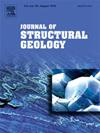云母质糜棱岩的微观结构演化
IF 2.9
2区 地球科学
Q2 GEOSCIENCES, MULTIDISCIPLINARY
引用次数: 0
摘要
在地壳剪切带中,云母的晶粒尺寸和几何排列随应变的变化有明显的变化。据推测,从板状、相互连接的云母层到混合良好的细粒超长岩微观结构的转变降低了岩石的粘度。据预测,这种演化对地壳的强度起着重要作用,特别是在板块边界。然而,高应变下云母层崩解和相混合的机理尚未得到广泛的探讨。在这项研究中,我们在圣路易斯华盛顿大学的大体积扭转装置(LVTs)上对云母(氟长云母)和方解石或萤石的合成复合材料进行了变形实验(高达γ>;100的剪切应变)。实验在T = 765°C, P = 1.5 GPa,应变速率为~ 1 × 10−4 s−1的条件下进行。利用光学显微镜、电子显微镜和电子背散射衍射(EBSD)对变形组织进行了分析。显微组织演化对剪切应变(γ)敏感,但对复合材料不敏感。云母晶粒尺寸通过脆性机制减小,相界滑动可以增强混合。相互连接的云母层在γ>;50时分解并与合成材料充分混合。这一变形过程序列也是通过对纳米比亚西南部纳玛夸变质杂岩中库考斯糜棱岩带标本的补充分析推断出来的。这种云母晶粒缩小和相混合的过程可能是高温地壳剪切带中糜棱岩向超糜棱岩转变的重要原因。本文章由计算机程序翻译,如有差异,请以英文原文为准。
Microstructural evolution of micaceous mylonites
In crustal shear zones, the grain size and geometric arrangement of mica is observed to evolve significantly with strain. The transition from tabular, interconnected mica layers to a well-mixed fine-grained ultramylonitic microstructure is inferred to reduce rock viscosity. This evolution is predicted to play an important role in the strength of the crust, particularly at plate boundaries. However, the mechanisms of mica layer disaggregation and phase mixing at high strains have not been widely explored. In this study, we conducted deformation experiments (up to shear strains of ) on synthetic composites of mica (fluorphlogopite) and either calcite or fluorite in the Large Volume Torsion Apparatuses (LVTs) at Washington University in St. Louis. Experiments were performed at T = 765 °C, P = 1.5 GPa, and strain rates of ∼1x10−4 s−1. Deformation microstructures were analyzed using optical and electron microscopy and electron backscatter diffraction (EBSD). Microstructural evolution is sensitive to shear strain (γ) but largely insensitive to the composited material. Mica grain size is reduced through brittle mechanisms and mixing may be enhanced by phase boundary sliding. Interconnected layers of mica disaggregate and are fully mixed with the composited material at . This sequence of deformation processes is also inferred from the complementary analysis of specimens from the Kuckaus Mylonite Zone in the Namaqua Metamorphic Complex in southwestern Namibia. This process of mica grain size reduction and phase mixing may contribute to the transition from mylonite to ultramylonite in high temperature crustal shear zones.
求助全文
通过发布文献求助,成功后即可免费获取论文全文。
去求助
来源期刊

Journal of Structural Geology
地学-地球科学综合
CiteScore
6.00
自引率
19.40%
发文量
192
审稿时长
15.7 weeks
期刊介绍:
The Journal of Structural Geology publishes process-oriented investigations about structural geology using appropriate combinations of analog and digital field data, seismic reflection data, satellite-derived data, geometric analysis, kinematic analysis, laboratory experiments, computer visualizations, and analogue or numerical modelling on all scales. Contributions are encouraged to draw perspectives from rheology, rock mechanics, geophysics,metamorphism, sedimentology, petroleum geology, economic geology, geodynamics, planetary geology, tectonics and neotectonics to provide a more powerful understanding of deformation processes and systems. Given the visual nature of the discipline, supplementary materials that portray the data and analysis in 3-D or quasi 3-D manners, including the use of videos, and/or graphical abstracts can significantly strengthen the impact of contributions.
 求助内容:
求助内容: 应助结果提醒方式:
应助结果提醒方式:


